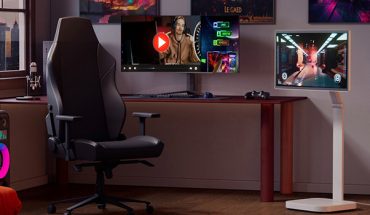Summertime means travel time! While it’s nice to get away in the winter as well, especially when you live in a country like Canada where the temperatures can become downright frigid, the summer months are also popular times to take vacation.
Whether you are traveling afar or exploring other parts of Canada, even a destination in your own backyard, there’s plenty of tech worth bringing along for the ride.
Extra Cables and Adapters
I never travel without more cables than I think I’ll need. I also pack at least two multi-port adapters that have a mix of both USB-C and USB-A outlets.
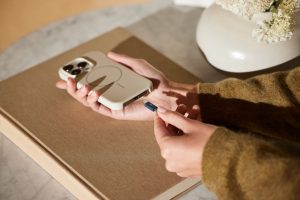
Beats Cable
For cables, I bring along both USB-A-to-USB-C since most multi-port adapters have more USB-A then USB-C ports, as well as USB-C-to-USB-C. Don’t forget an adapter for your headphones: even if they’re wireless, many can function with a wired connection and most mobile devices nowadays don’t have a 3.5mm port. This will come in handy for a seatback entertainment system on a plane, since most do not support wireless transmission.
While most devices nowadays charge via USB-C, don’t forget proprietary chargers for items like your smartwatch. Beats has a new line of USB-C-to-USB-C and USB-C-to-USB-A cables that sell for $25 each and come with woven cables, long five-foot lengths (great for hotel rooms), and full compatibility with Apple CarPlay, making them a solid choice for road trips as well.
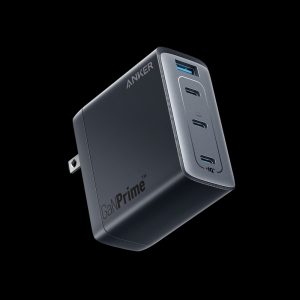
Anker 747 Charger
When it comes to adapters, I’d stick with a reputable brand like Anker. The Anker 747 Charger is $100 and comes with three USB-C and one USB-A port along with more efficient GaN technology, temperature protection to prevent overheating, foldable AC prongs, and a compact design that makes it perfect for travel.
Good Noise-Canceling Headphones
Whether you’re traveling by plane, train, or car, a god pair of noise cancelling headphones are essential. For a plane, train, or bus, they help cancel out the loud engine noise so you can enjoy peace and quiet while you take a nap or enjoy mobile entertainment. For car rides, kids will enjoy wearing a pair while watching movies or playing games in the backseat while the parent in the passenger seat can listen to their own tunes or have private conversations. Naturally, the ‘phones should offer long battery life to last for the full trip. Transparency mode is useful, too, so you can hear things like flight announcements or someone talking next to you without having to remove the ‘phones from your ears.

Sonos Ace headphones
My go-to pair nowadays are the Sonos Ace headphones ($599), but you’ll find great options from other brands, too. One of my favourites are the JBL Live 770NCs ($300). If you prefer to travel light and save room in your carry-on, I have worn the Panasonic Technics EAH-AZ-100s ($400) true wireless earbuds on several flights and they offer impressive noise cancellation for buds versus over-ear headphones.
Portable Charging Bank
I don’t just use my phone while traveling to keep in touch with others. It’s also my camera for taking photos as well as my navigation devices for getting around unfamiliar destinations. Plus, you might want to use it for things like real-time translations when traveling in foreign countries. I only ever buy portable charging banks that either have built-in cables for a direct connection to your device or MagSafe magnetic chargers. The latter will work with newer iPhones. If you have an Android device, make sure to get a MagSafe compatible case so you can connect the charger to that and stay powered on the go.
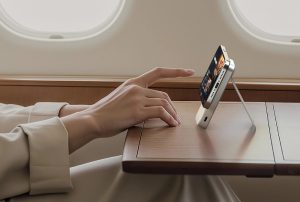
Satechi OntheGo Power Bank (10K)
I’d go for one with at least a 10,000mAh battery that can get you one full recharge of a larger phone or tablet, or more. The Satechi OntheGo Power Bank (10K) fits the bill. At US$90, it comes in three colours and employs a slim design that’s easy to slip into a pocket. It affords Qi2 wireless charging with compatible devices (it’s still backwards compatible with standard Qi) and even has a built-in stand for using it tabletop.
Mobile Device (Beyond Your Smartphone)
Don’t make your smartphone do all the heavy lifting. I often use my smartphone to watch downloaded content on a flight. This can drain the battery quickly. While I can use my power bank to keep it charged up, that means I’ll be without back-up wireless power once I arrive. Many airplanes have USB-A or AC ports for charging, but let’s be honest: they don’t always work. It’s a good idea to bring along a secondary device for entertainment so you can save your phone for the essentials.
The OnePlus Pad 3 is a fantastic option. It’s ultra slim yet has a massive 13.2-inch screen, so you get
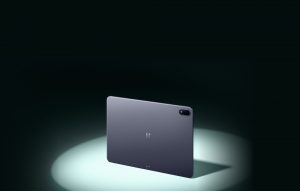
OnePlus Pad 3
the feel of a laptop without having to lug one around. Add a folio case and you can prop it up on a tray table to watch a movie. Use it in the hotel room to play games, watch videos, even video call friends and family members back home. Add the Stylo 2 stylus and brainstorm activity ideas or jot down phone numbers for making dinner reservations or booking tickets. At $1,000 (accessories are extra), you’ll find it just as useful as a second screen at home, too.
Portable Bluetooth Speaker
I recently went a vacation to Mexico with family and friends and brought along the JBL Flip 7 portableBluetooth speaker, which is just $190. It’s the perfect size for tossing in your carry-on (yes, it’s approved to go through security) without adding too much bulk or weight. It’s water-resistant so you can use it by the pool or even at the beach. It even has a handy PushLock system and comes with two accessories, a loop for hanging or holding and a carabiner for clipping. Enjoy fabulous audio and booming bass, plus up to 16 hours of playtime per charge using Playtime Boost. It’s a great unit to bring up to the cottage, too. If you want even bigger sound, go with the larger but still portable JBL Charge 6, which sells for $250.
it’s approved to go through security) without adding too much bulk or weight. It’s water-resistant so you can use it by the pool or even at the beach. It even has a handy PushLock system and comes with two accessories, a loop for hanging or holding and a carabiner for clipping. Enjoy fabulous audio and booming bass, plus up to 16 hours of playtime per charge using Playtime Boost. It’s a great unit to bring up to the cottage, too. If you want even bigger sound, go with the larger but still portable JBL Charge 6, which sells for $250.
Bluetooth Tracking Devices
I love that Air Canada now allows you to track your luggage in the app. But it’s always a good idea to bring along your own tracking device. I use an Apple AirTag on my keys to ensure I never accidentally leave them behind. You can pop one in the pocket of your suitcase or attach it to valuables like your wallet, or place it in your purse or eyeglasses case to ensure you don’t forget it.
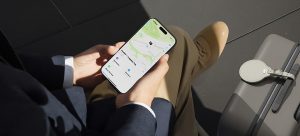
Satechi Luggage tag
Apple AirTags start at $39 and you’ll need a keyring as well. They use the Find My network so you can be assured that any lost or misplaced items can be retrieved with the help of the millions of other Apple device users. Satechi also has a new collection of FindAll devices, including a keychain, luggage tag, card, glasses case, and passport cover, all of which also leverage Apple’s Find My network.
Downloaded Content
Before we’ll be away from home for any length of time, I always remind my family members to download content to their devices. Even if you have loads of data in your plan, why not save it? Download content to your device when you’re at home and connected to Wi-Fi so you can enjoy a movie, TV shows, or a music playlist while traveling without eating through your data.
I usually download a selection of content from different streaming services like Netflix, Disney+, and Crave so I have choice depending on what I’m in the mood to watch. Just don’t forget to delete these downloads once you’re done watching so they don’t take up valuable storage space on your device.
eSIM
Every carrier offers flat-fee roaming packages that allow you to use your device as you do at home, including calls, text messages, and data, without worrying about extra fees. But they can be pricey, ranging anywhere from an additional $10 to $15 per day on top of your regular monthly plan price. It offers peace of mind but adds up for a week’s vacation. Instead, turn data roaming off on your phone, purchase an eSIM, download it to the device, and activate it right before you arrive. Once at your destination, you can use the data bucket you’ve purchased for a nominal fee.
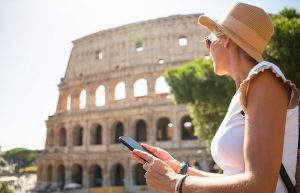
2129358257
For a recent trip to Mexico, for example, I spent $15 for a 30-day 5GB data eSIM from Canadian provider Always Mobile, which was more than enough for the nine days I was there. Just note that if you answer or make a cellular phone call or send/receive an SMS, you will be charged the long-distance or per-text rate, regardless of what you have with your regular plan. But if you can manage to stick to data only, opting for WhatsApp Audio or FaceTime for calls and iMessage or RCS for text-based messages, you’ll save big time.
Safe summer travels!

